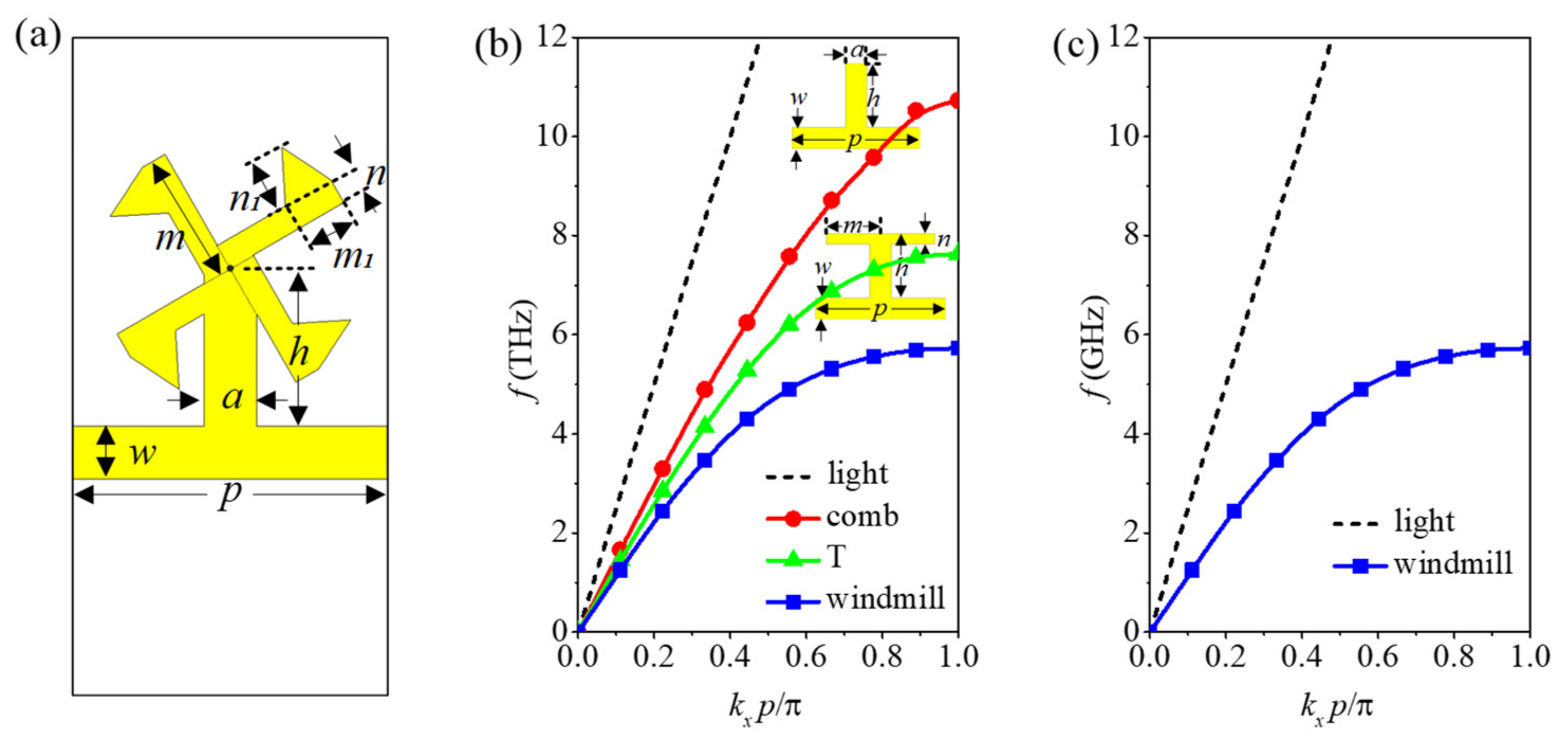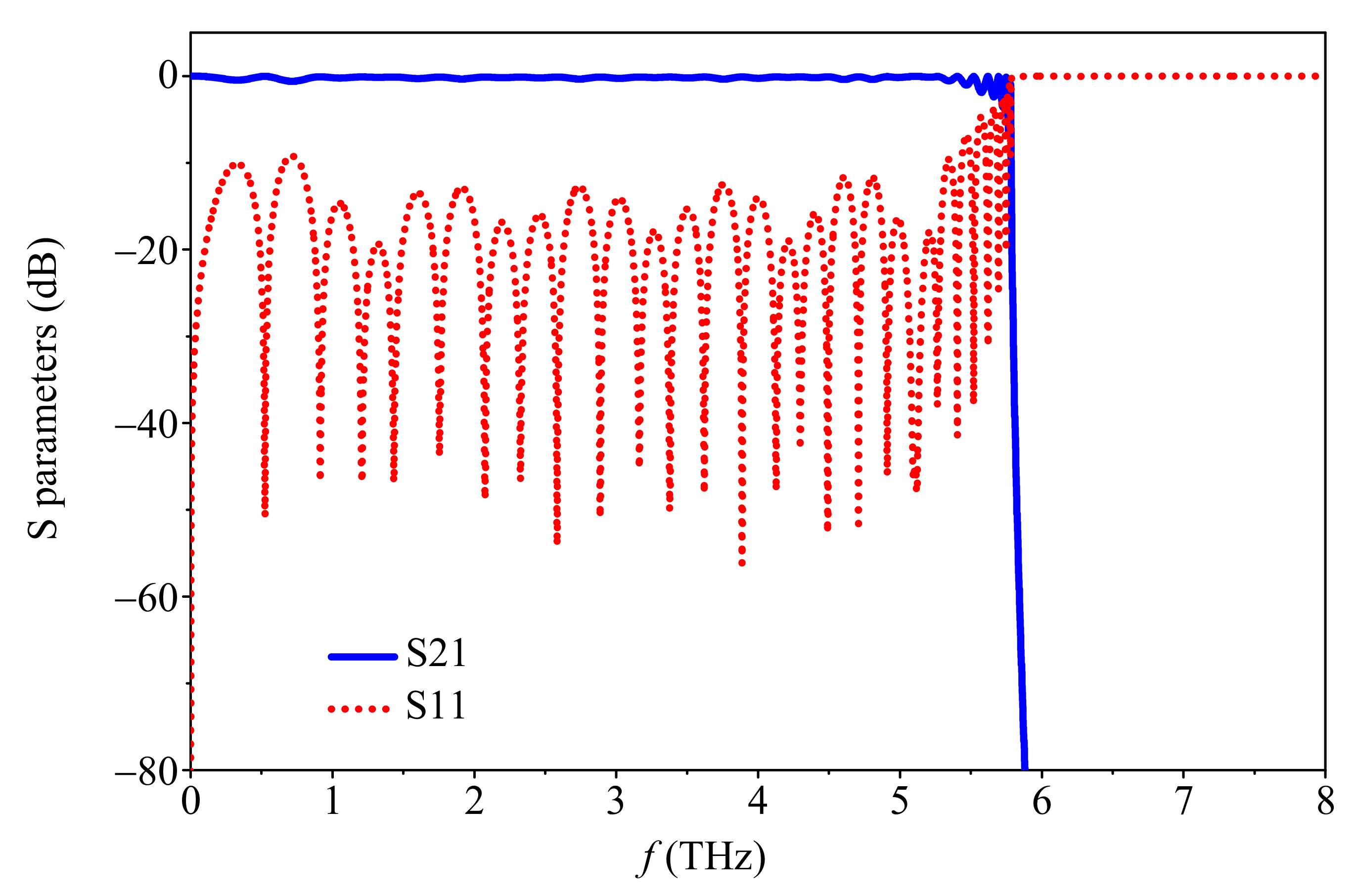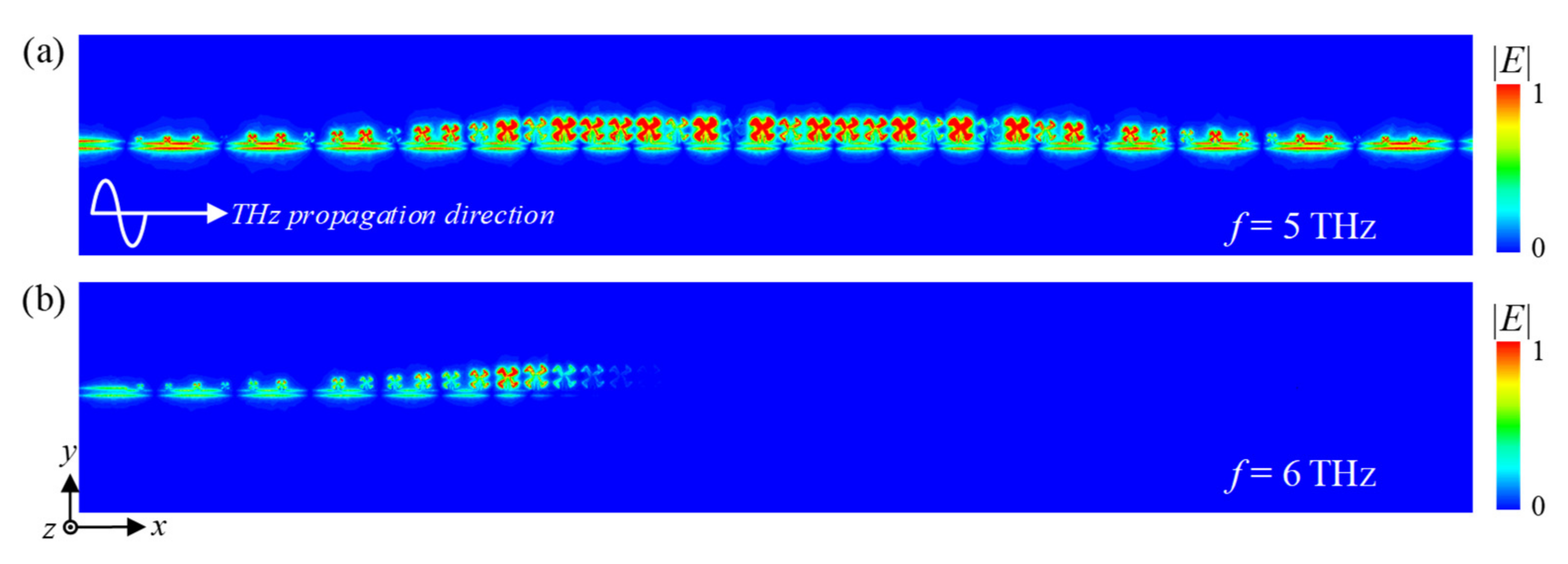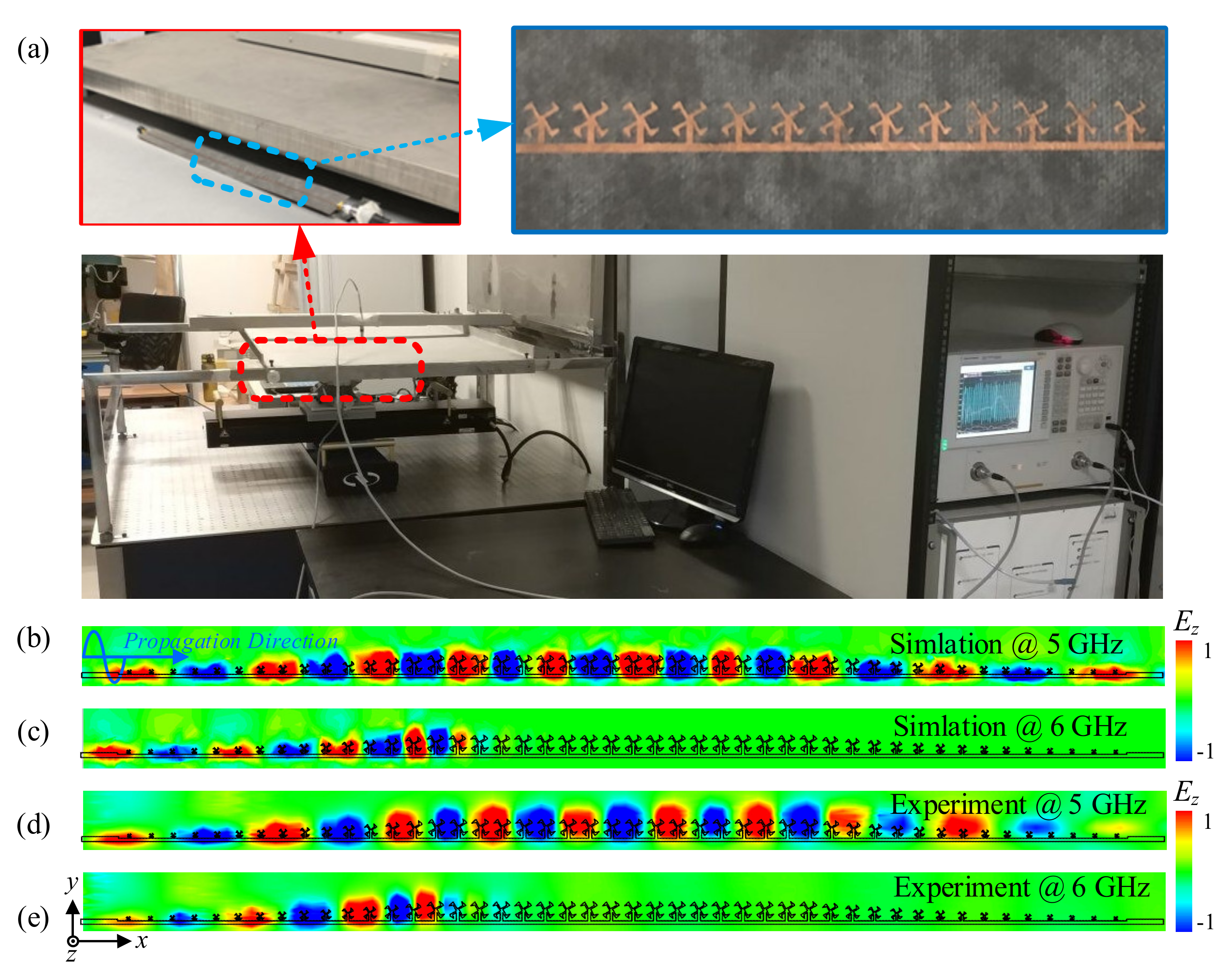A Windmill-Shaped SSPP Waveguide for High-Efficiency Microwave and Terahertz Propagation
Abstract
:1. Introduction
2. Dispersion Characteristics of the Windmill-Shaped SSPP Unit
3. Results and Discussion
4. Conclusions
Author Contributions
Funding
Institutional Review Board Statement
Informed Consent Statement
Data Availability Statement
Conflicts of Interest
References
- Barnes, W.L.; Dereux, A.; Ebbesen, T.W. Surface plasmon subwavelength optics. Nature 2003, 424, 824–830. [Google Scholar] [CrossRef] [PubMed]
- Lal, S.; Link, S.; Halas, N.J. Nano-optics from sensing to waveguiding. Nat. Photon. 2007, 1, 641–648. [Google Scholar] [CrossRef]
- Kawata, S.; Inouye, Y.; Verma, P. Plasmonics for near-field nano-imaging and superlensing. Nat. Photonics 2009, 3, 388–394. [Google Scholar] [CrossRef]
- Ozbay, E. Plasmonics: Merging Photonics and Electronics at Nanoscale Dimensions. Science 2006, 311, 189–193. [Google Scholar] [CrossRef] [PubMed]
- Falk, A.; Koppens, F.; Yu, C.L.; Kang, K.; Snapp, N.D.L.; Akimov, A.; Jo, M.-H.; Lukin, M.D.; Park, H. Near-field electrical detection of optical plasmons and single-plasmon sources. Nat. Phys. 2009, 5, 475–479. [Google Scholar] [CrossRef]
- Wait, J. The ancient and modern history of EM ground-wave propagation. IEEE Antennas Propag. Mag. 1998, 40, 7–24. [Google Scholar] [CrossRef]
- Pendry, J.B.; Martin-Moreno, L.; Garcia-Vidal, F.J. Mimicking surface plasmons with structured surfaces. Science 2004, 305, 847–848. [Google Scholar] [CrossRef]
- Hibbins, A.P.; Evans, B.R.; Sambles, J.R. Experimental Verification of Designer Surface Plasmons. Science 2005, 308, 670–672. [Google Scholar] [CrossRef] [Green Version]
- Maier, S.A.; Andrews, S.R.; Martin-Moreno, L.; Garcia-Vidal, F.J. Terahertz surface plasmon polariton propagation and focsing on periodically corrugated metal wires. Phys. Rev. Lett. 2006, 97, 176805. [Google Scholar] [CrossRef] [Green Version]
- Cano, D.M.; Nesterov, M.L.; Fernandez-Dominguez, A.I.; Garcia-Vidal, F.; Martin-Moreno, L.; Moreno, E. Domino plasmons for subwavelength terahertz circuitry. Opt. Express 2010, 18, 754–764. [Google Scholar] [CrossRef] [Green Version]
- Poulin, M.; Giannacopoulos, S.; Skorobogatiy, M. Surface Wave Enhanced Sensing in the Terahertz Spectral Range: Modalities, Materials, and Perspectives. Sensors 2019, 19, 5505. [Google Scholar] [CrossRef] [PubMed] [Green Version]
- Papari, G.P.; Koral, C.; Andreone, A. Geometrical Dependence on the Onset of Surface Plasmon Polaritons in THz Grid Metasurfaces. Sci. Rep. 2019, 9, 924. [Google Scholar] [CrossRef] [PubMed] [Green Version]
- Papari, G.P.; Mazaheri, Z.; Koral, C.; Andreone, A. Dispersion diagram of surface plasmon polaritons from angular transmission investigation. Opt. Lett. 2021, 46, 2601–2604. [Google Scholar] [CrossRef] [PubMed]
- Shen, X.; Cui, T.J.; Cano, D.M.; Garcia-Vidal, F.J. Conformal surface plasmons propagating on ultrathin and flexible films. Proc. Natl. Acad. Sci. USA 2012, 110, 40–45. [Google Scholar] [CrossRef] [Green Version]
- Ye, L.; Xiao, Y.; Liu, Y.; Zhang, L.; Cai, G.; Liu, Q.H. Strongly Confined Spoof Surface Plasmon Polaritons Waveguiding Enabled by Planar Staggered Plasmonic Waveguides. Sci. Rep. 2016, 6, 38528. [Google Scholar] [CrossRef] [Green Version]
- Ye, L.; Feng, H.; Cai, G.; Zhang, Y.; Yan, B.; Liu, Q.H. High-efficient and low-coupling spoof surface plasmon polaritons enabled by V-shaped microstrips. Opt. Express 2019, 27, 22088–22099. [Google Scholar] [CrossRef]
- Ye, L.; Xiao, Y.; Song, Z.; Liu, N.; Zhang, W. Plasmonic waveguide with folded stubs for highly confined terahertz propagation and concentration. Opt. Express 2017, 25, 898. [Google Scholar] [CrossRef]
- Gao, X.; Zhou, L.; Yu, X.Y.; Cao, W.P.; Li, H.O.; Ma, H.F.; Cui, T.J. Ultra-wideband surface plasmonic Y-splitter. Opt. Express 2015, 23, 23270–23277. [Google Scholar] [CrossRef]
- Ye, L.; Zhang, W.; Ofori-Okai, B.K.; Li, W.; Zhuo, J.; Cai, G.; Liu, Q.H. Super subwavelength guiding and rejecting of terahertz spoof SPPs enabled by planar plasmonic waveguides and notch filters based on spiral-shaped units. J. Lightwave Technol. 2018, 36, 4988–4994. [Google Scholar] [CrossRef]
- Ye, L.; Chen, Y.; Da Xu, K.; Li, W.; Liu, Q.H.; Zhang, Y. Substrate Integrated Plasmonic Waveguide for Microwave Bandpass Filter Applications. IEEE Access 2019, 7, 75957–75964. [Google Scholar] [CrossRef]
- Feng, H.; Ye, L.; Zhang, Y.; Li, W.; Chen, H.; Liu, Q.H. Bidirectional multi-mode microwave vortex beam generation enabled by spoof surface plasmon polaritons. Appl. Phys. Lett. 2020, 117, 241601. [Google Scholar] [CrossRef]
- Ye, L.; Chen, Y.; Zhuo, J.; Feng, H.; Zhang, Y.; Liu, Q.H. High-performance spoof surface plasmon polariton waveguides and splitters based on Greek-cross fractal units. J. Phys. D Appl. Phys. 2020, 53, 235502. [Google Scholar] [CrossRef]
- Zhang, X.-F.; Fan, J.; Chen, J.-X. High Gain and High-Efficiency Millimeter-Wave Antenna Based on Spoof Surface Plasmon Polaritons. IEEE Trans. Antennas Propag. 2018, 67, 687–691. [Google Scholar] [CrossRef]
- Ye, L.; Chen, Y.; Wang, Z.; Zhu, C.; Zhuo, J.; Liu, Q.H. Compact Spoof Surface Plasmon Polariton Waveguides and Notch Filters Based on Meander-Strip Units. IEEE Photononics Technol. Lett. 2020, 33, 135–138. [Google Scholar] [CrossRef]
- Ye, L.; Wang, Z.; Zhuo, J.; Han, F. A Back-fire to Forward Wide-Angle Beam Steering Leaky-wave Antenna Based on SSPPs. IEEE Trans. Antennas Propag. 2022. [Google Scholar] [CrossRef]
- Kim, Y.; Salim, A.; Lim, S. Millimeter-Wave-Based Spoof Localized Surface Plasmonic Resonator for Sensing Glucose Concentration. Biosensors 2021, 11, 358. [Google Scholar] [CrossRef]








Publisher’s Note: MDPI stays neutral with regard to jurisdictional claims in published maps and institutional affiliations. |
© 2022 by the authors. Licensee MDPI, Basel, Switzerland. This article is an open access article distributed under the terms and conditions of the Creative Commons Attribution (CC BY) license (https://creativecommons.org/licenses/by/4.0/).
Share and Cite
Wang, Z.; Feng, H.; Yang, X.; Xu, X.; Zheng, Y.; Ye, L. A Windmill-Shaped SSPP Waveguide for High-Efficiency Microwave and Terahertz Propagation. Electronics 2022, 11, 1293. https://doi.org/10.3390/electronics11091293
Wang Z, Feng H, Yang X, Xu X, Zheng Y, Ye L. A Windmill-Shaped SSPP Waveguide for High-Efficiency Microwave and Terahertz Propagation. Electronics. 2022; 11(9):1293. https://doi.org/10.3390/electronics11091293
Chicago/Turabian StyleWang, Zhihui, Hao Feng, Xiaofan Yang, Xiong Xu, Yunxing Zheng, and Longfang Ye. 2022. "A Windmill-Shaped SSPP Waveguide for High-Efficiency Microwave and Terahertz Propagation" Electronics 11, no. 9: 1293. https://doi.org/10.3390/electronics11091293





